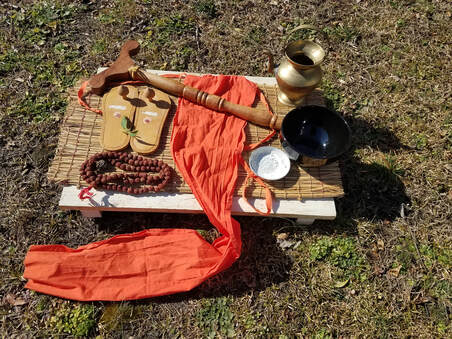 Yogis traditional kept few personal possessions, but all or most of these would be considered essential. Can you identify them? Do you know the purpose and significance of each? Do you use any in your practice? These are 1) gurupaadukaas, 2) kamandalu, 3) yogadanda, 4) aasana, 5) rudraakshamaalaa, 6) vibhuuti, 7) tulasiidalam, 8) kaupiinam, and 9) bhikshaabhaandam.  1) Guru Padukas (Holy Sandals of the Master) According to all the traditional texts on Yoga, before a person can begin a practice of Yoga, they must receive the blessings of a realized Guru. It is the nature of the ahamkara (ego) to bind itself and to remain bound, and the nature of the realized master to stimulate awakening in the disciple. Wooden padukas are the traditional footwear of Yogis. The wood protects the feet not only from physical objects which would injure the feet, but also from all sorts of impurities and negative energies on the ground. This style of foot wear is anything but comfortable, and it requires the utmost mindfulness to constantly clutch with the toes. Having worn only wooden padukas for several years. I can attest that it is an awkward exercise in mindfulness to wear them, with injury the result for a momentary lapse of attention (especially on stairs). I was amazed to see one of my masters who is well into his 70's walking in padukas in an extremely graceful way as if he was floating. Guru padukas are the holy sandals of the Guru. They are a symbol of the master. Whenever the student sees the teacher, they rush forward to receive blessings by bowing and touching the holy feet of the teacher. Yoga understands that much energy leaves the body through the feet and that powerful energy to stimulate our process of awakening imbues the seeker who makes themselves humble before a master. When encountering the footwear of the master, the disciple will bow and seek blessings, because even the chappals are blessed by the contact with the master's holy feet. When the disciple can not be in the physical presence of the master, a small pair of padukas is kept for worship. This helps maintain mindfulness on the blessing of the Guru's grace, without which no progress wold be possible on the path of Yoga. This is why we are listing gurupadukas as the foremost prop for any yogi.  2) Kamandalu (Water Pot) Kamandalu is a water pot, often with a handle at the top and a spout. Traditionally used by Yogis for carrying water for drinking and for offering in prayers. Many Yogis pour morning tarpana oblations to the Sun from the sacred kamandalu. Water is a must in every puja ceremony, and most rituals for purification, like punyahavachanam, rely heavily on the use of pure water. The kamandalu has become not only the symbol of a the simple, austere, self-sufficient life of a Yogi, but also a symbol of spiritual purity which comes to the Yogis who maintain an austere existence, remaining aloof from society, abstaining from material pleasures and comforts, and remaining absorbed in their quest for realization. The kamandalu has become a symbol of the Yogi's absorption in their quest for God, and of ascetic aspects of God like Shiva. The kamandalu is also a symbol of the lifegiving powers of water and of amrita (the nectar of immortality). As such, it is associated with deities who relate to water like Varuna and Saraswati.  3) Yoga Danda / Japa Danda (Stick for Mantra Japam) A Yoga Danda is a stick, usually made from wood, constructed with a support at one end, designed for use in mantra japa. The Yoga danda enables long hours of mantra repetition, counting the mantras recited with a japamala, so that the mala can be held without touching impurities on the ground. Items used in the practice of Yoga are regarded as sacred and are always treated with the utmost respect. This includes not touching them mindlessly, not moving them around hastily or carelessly, not touching them with the feet or touching them to impure objects like dirt or waste, not allowing them to touch the ground, and not allowing them to be seen casually by people who lack reverence and respect for their sacred nature. Yogis often use the Yoga danda in conjunction with a cloth to cover the japamala from drishti (a gaze from onlookers which transfers negative energy). Japa is possibly the most important of the higher practices of Yoga. It is different than affirmation, as it uses sacred Sanskrit sounds to open inner channels and to carry consciousness transcendent states of awareness. It is different also from kirtan or bhajana, where mantras are sung in musical ways, which is more of a practice of bhakti Yoga. The practices of bhakti Yoga help to instill a love of the Divine which helps later to give the aspirant the faith and courage to persist in the higher practices of Yoga. Japa is repetitive and very dull. It is a meditation.  The straightness of the Yoga danda is a symbol of the stillness and steadiness of focus required for japa to bestow its effects. It is a support to the Yogi in their countless hours of practice. Through such practice, the Yoga danda is endowed with mystical powers as it vibrates potently with the power of the mantra. Contact with or sight of such a sacred object is capable of healing diseases, answering questions, and inducing higher states of consciousness. The Yoga Danda is different from the Brahma danda carried by brahmacharis (those who have taken vows of celibacy) including sannyasins. This staff is more of a walking stick designed to support such wandering ascetics in their travel from place to place. It is a symbol of the central channel of awakening within the spine, the sushumna nadi, and a symbol of their independence and self-sufficiency.  4) Asana (Seat / Meditation Mat) The asana is considered an indispensable prop for traditional Yoga practice. People wrongly think that asana means various postures, but asana means to sit, or in this case a seat for sitting on for meditation and mantrajapa. The Yoga sutras of Patanjali say only "Sit in a comfortable posture" in reference to asana and does not mention a single pose. Most of the other older texts on Yoga list only a small handful of poses, which are mainly sitting poses for meditation. It was not until the 20th century when modern Indians, who were not Yogis, began to add stretching poses of modern aerobics to the practice of Yoga in an effort to make the esoteric practice of the mystics more widely applicable to the general public. The importance of an asana, or a seat for practice is based in mystical knowledge of transfer of energy. Asanas made of certain, pure substances help to prevent the loss of spiritual energy through the legs and feet as they come in contact with the ground, and they help to create a protective barrier from negative energies which would otherwise be transferred from the ground and hinder the Yogi's meditation. Suitable substances for construction of an asana are said to be wood, cotton, wool, silk, darbha grass, or animals skins. Animal skins should be tanned from animals that have died of natural, peaceful causes, and the best are said to be from a tiger, lion, deer, or antelope. It is possible for an asana to be made of various layers of all these substances. Obviously, wool, silk, cotton, or animal hide is the easiest to travel with for wandering Yogis and therefor the most common. Wooden and dharbha asanas are more common in Temples and homes for puja ceremonies. There are various yantras drawn on asanas along with specific mantras for purification which are used to purify and empower the asana for use. As an asana is used repeatedly for sadhana, spiritual energy builds and it helps to empower one's practice. Its use may seem excessive to novice practitioners of Yoga, but for the mystical Yogi attuned to the subtle energies around and aware of their effects on consciousness the asana is an invaluable tool to help empower the practice of Yoga.  5) Rudraksha Mala (Strands of Sacred Rudraksha Seeds) Rudraksha mala is worn by nearly all Yogis. Rudrakshas are the sacred seeds of the bright blue fruit of the Rudraksha tree, Elaeocarpus ganitrus, native to the foothills of the Himalayas in India and Nepal. They are very sacred to Hindus and many Buddhists for their sacred nature and effect on consciousness. Contact with rudrakshas is said to calm the mind, increase spiritual awareness, and lower blood pressure. The beads are used to make japamalas for mantra practice and kanthamalas for wearing. Wearing rudrakshas is said to have a protective energy and helps keep a person current facing their karmas. Rudrakshas open a channel to inner realms to deepen meditation and help a person to connect with the devas. Yogis wear rudrakshas at all times to aid in their practice and to help avert negative energies and keep them connected with the devas. It is said that a person who wears rudrakshas at the time of death will be benefitted to have their astral body projected to the higher astral realms and not suffer from being caught in the hellish lower astral realms after death. Rudrakshas have lines along them called mukhis or faces. Five mukhis is most common. Each mukhi rudraksha 1-12 is said by the scriptures to have specific energies and abilities relating to various Planets in Vedic astrology and capable of helping with specific problems. Some like the one mukhi rudraksha are very rare and sell for a great deal of money. Because of this, it is common to encounter fake rudrakshas. For general use, the 5 mukhi rudrkasha is best. The Rudrakshajabala Upanishat says: "Wearing rudraksha removes the sins committed in day and night. Seeing it produces 100 thousand benefits, and touching it produces 10 million. Wearing it produces a billion benefits, and wearing and counting mantras on the beads produces 100 billion benefits."  6) Vibhuti / Bhasma (Holy Ash) Vibhuti or Bhasma is the sacred white ash which is very dear to yogis and sadhus. The ash, 'bhasma' is made in a proscribed method, building a fire using dried cow dung and darbha grass. Offerings are made into the fire of ghee and sesame seeds to empower the sacred ash with specific mantras. Pure white ash is then collected and powdered finely and sometimes scented for use. The sacred ash empowered in this way is known as vibhuti, or 'powerful.' Vibhuti is applied as a part of the traditional tilakam, or sectarian markings on the forehead, arms and chest of Shaivas, Shaktas and Smartas along with specific mantras, and the othodox never leave home without wearing it. If vibhuti prepared in this way is unavailable, the shastras allow the use of any ash from a sacred fire where offerings are made regularly. The vamamarga shastras also allow the use of ash from cremation grounds, and many naga and aghori sadhus use this. Vibhuti is most commonly applied in three vertical lines called, tirpundra. According to Shaiva philosophy, these lines represent the burning away of the three pashas, or 'bonds of the embodied soul.' These are anava, 'the false sense of being limitted;' karma, 'action arising from this delusion;' and maya, 'the phenomenal world which arises due to action.' Vibhuti has mystical powers to open a channel to the inner realms. It casts an emanation of astral light around the wearer through which the Devas can see into the physical realm. Vibhuti has a purifying effect upon consciousness, keeping a person current with their karmas, and it has a protective effect. Wearing vibhuti protects from all sorts of negative energies from people and places one goes and actually can help to protect from physical dangers as well. When performing the pancha agni sadhana, the austerity of sitting in fire, Yogis first place vibhuti on the body to protect from physical burning. When Yogis pierce the tonque and skin with metal spikes as a part of traditional kavadi offerings to Lord Murugan, they place vibhuti on the skin before inserting the metal spike to reduce bleeding, infection, and other forms of lasting damage to the body. Vibhuti has such a strong purifying effect that if water is not available, "agneya snanam" is considered permissible, which is to bath using holy ash. It is a very powerful practice of purification, in fact many times more powerful than a regular water bath to apply vibhuti all over the body head or toe. Vibhuti is always offered to Lord Shiva, and is commonly offered as prasad (a blessed sacrament) at Shiva temples. Small amounts are eaten for healing from serious diseases. The Skanda Purana says that if a person performs any act of worship of the Lord while wearing bhasma, it will have great effects to purify that person and uplift them toward spirituality, even if they lack faith and merely do the outer actions of worship. This is the sacred power of vibhuti.  7) Tulasi Dalam (Holy Basil Leaf) Tulasidalam - Tulsi or Holy Basil leaf is very sacred to the Vaishnavas who worship the plant as a Goddess incarnate. Unlike most other substances on earth which are said to require prana pratishtha rituals to open channels to the inner realms before they are considered fit for worship, Tulasi is said to occur naturally with those channels fully open. Offered in every Vaishnava puja, tulasi is considered an essential substance for prayer. Malas are made for wearing and japa out of beads carved from the sacred wood. The tulasi plant is also a veritable medicine chest. The fragrant leaves are capable of helping to cure any dis-ease condition a Yogi may experience. They even have the capacity to bring the dead back to life, which is why they are a compulsory offering in every Hindu funeral ceremony. Tulasi leaves are offered to ensure it is the Lord's will for the soul to depart before funeral pyres are ignited. Having sacred tulasi leaves nearby means for wandering yogis that the cure to any potential dis-ease condition is nearby. Living a self imposed transitory life of poverty and austerity means that medicines are not always available to a yogi. The great Yogis have revealed simple practices for self-healing for such wandering ascetics. Consuming tulasi daily not only uplifts a person's awareness and calms the mind for meditation, but it also boosts ojas (immunity) to help prevent dis-ease. Like rudrakshas, tulasi has the capacity to attract divine beings and to keep a person current processing their karmas. With the proper knowledge, tulasi can be used to treat any health concern, but few know of the mystical healing uses of tulasi to treat various diseases. The yogis have passed this information down through the generations. This is very similar to the more well known practice of shivambu, involving drinking one's own urine for health and using urine to treat various diseases. These practices are especially important for yogis since they are often exposed to harsh environmental conditions living outside and often go without food and water for long periods of time. Such yogis sometimes eat several peppercorns each day when food is not available to encourage the body to recycle the nutrients of the food they have digested already. The wandering yogi may not always be able to take proper care of the body, or to afford needed medications, but it is always possible to carry a little tulasi or to produce a little urine. Tulasi is a great aid in practice and a literal lifesaver for the yogis subjected to harsh conditions in order to press forward in their sadhana. Tulasi Gayatri Mantram Tulasi-devyai ca vidmahe viShNu-priyaayai ca dheemahi tanno vrindaah pracodayaat "May we know that Goddess Tulasi and meditate on the beloved of Lord Vishnu May that Tulasi, with a cluster of flowers, bestowing virtue and strength, impel us."  8) Kaupina (Loincloth) The simple Kaupina is the basic traditional garment of Yogis, Ascetics, and Brahmacharis. Before the modern fashion trends of commercialized Yoga, this simple loincloth was a symbol of humbleness, austerity, and renunciation for Yogis. This is vastly different from modern stylish Yoga garb which are designed to bring attention to the physical body, objectify women, and put money in the pockets of an ever-growing 80 billion dollar global industry taking advantage of the materialistic nature of humanity by commodifying the once spiritual practice of Yoga. Unlike the many expensive Yoga fashions peddled by the Yoga companies, the kaupina is the humblest of garments, worn in India by the impoverished out of necessity and by Yogis and renunciates as spiritual austerity. A kaupina can be easily made at home from plain cloth. It is a loincloth constructed of a string or piece of cloth which is tied around the waist. To this a piece of cloth is attached which is secured firmly between the legs by pulling it through the string itself (see illustration below). Though some ascetic Yogis have worn nothing more than the kaupina as act of extreme austerity, it is today most commonly worn under the tradition veshti or other clothing by Yogis and brahmacharis. The design of the kaupina itself is a great aid in the practice of brahmacharya (celibacy). The kaupina places gentle pressure around the genitals, stimulating marma points which help to subjugate the sexual urge and activate the higher chakras. For men in particular, the kaupina is a great aid in the practice of brahmacharya because it makes it very painful if arousal occurs. Though it is more common for men to wear kaupina, it is useful and acceptable for women to wear it also. Women have traditionally worn kaupina during their monthly cycle and its design is supportive to the practice of bramacharya for women also. It can be worn under saree or other garments. Blessed with mantras when wearing, the kaupina is not only a symbol of renunciation of materialism which is a great obstacle in the path of Yoga, but a support and constant reminder of the inner quest of the Yogi.  This garment is the fundamental article of clothing of the Yoga practitioner and a potent symbol of their renunciation. The scriptures extol the greatness of the lowly kaupina and many deities like Shiva, Hanuman and Palani Murugan have been depicted wearing it. Modern Sages like Ramana Maharishi and Nityananda of Ganeshpuri are most often seen wearing only kaupina. Adi Shankaracharya's "Kaupina Panchakam" says: "Always contented in the joy of ones own self Who is peaceful by curbing the desires of his senses Who is immersed day and night in the bliss of Brahman The man with just the loincloth is indeed the lucky one."  9) Bhikshaa Bhaandam (Begging Bowl) Picture The Bhikshaa bhaandha or begging bowl is the universal symbol of Yogis and Sadhus in India. Made from wood, earthenware, or metal, the begging bowl is a necessity for the practice of Yoga. Followers of the lefthanded path like the Nagas and Aghoris often use human skulls as begging bowls to remind them of the impermanence of life. There are few things more humbling than having to beg for ones livelihood. Many times alms are refused and the beggar insulted. Traditionally, Yogis and Sadhus do not remain in one place, but roam from town to town, never remaining in one location for longer than three days at a time to avoid developing attachments. Traditionally, they are permitted by tradition to knock on three doors with their begging bowl each day asking for food. If food is denied three times, they fast that day. This practice, is one which is practical in the East where Yogis are revered as Holy people, and it is understood that their intense dedication and sadhana has a stabilizing effect on society and human consciousness. People rush forward to give bhiksha or alms to Yogis, because they know that it opens a channel for them and their families to have their karmas and troubles healed by the punyam (the merit) accrued from the many austerities practiced by the Yogi. Householders in the East understand that it is their spiritual duty to give food, and clothing, and money to support the mission of dedicated spiritual seekers. Traditionally, the Yogi does not just receive bhiksha, but must give karmakanda in return. Karmakanda in this context means the blessing given by a Holy person to those benefactors who sponsor the efforts of the holy person by giving alms. Though people may not have the karma to experience healing or realization on account of their own merits, the act of giving bhiksha opens an energetic channel to the holy person enabling that mystic access to the subtle bodies where a persons karmas are held and carried from life to life. In the highest sense, the Yogi's duty upon receiving bhiksha is to aid in working out the karmas which bind and hinder those who have given alms. In certain cases, there will be no outer action to symbolize this inner work which the Yogi is duty bound to complete. In other cases, the Yogi will demonstrate outwardly the karmakanda by either providing spiritual teachings, pooja services or other spiritual services. Free from attachments, the earlier Yogis wandered place to place with little more than the sacred bhiksha bhanda as an implement signifying faith in the Lord's undying support. Their hearts and minds are open like the empty bowl to whatever the Lord brings into their path, and like the empty bowl which can be filled with food by generous yajamanas, their being is like a blank slate for the grace of God to flow through. Few in the West understand the seriousness of the practice of the Yogis in the East nor do they see it as their duty to support the efforts of such spiritual seekers. People often lack compassion and generosity. Many are the stories of God coming to a person's home in the form of a beggar to test people's spirit of generosity. It is true that those who give, earn the karma to receive; and that those who deny any person in need, will themselves be denied in the future when they find themselves most in need. We must give to receive, which is a secret that is understood well in the East. For people in the West, the focus is on materialism and material comforts are abundant, but the bhiksha bhanda is empty and our hearts and minds are lacking spiritual bliss and tranquility. In order to bring back this ancient and beneficial tradition of bhiksha / karmakanda, we must start by giving generously to all in need. The enlightened masters are taking birth in the East, because there the system supports their existence and there the people are open to their spiritual assistance. To attract such souls back to the West, we must learn to look at all beggars as God himself asking for us to sacrifice a little and give of the abundance we enjoy. We must begin again to see it as our duty to donate generously to all spiritual institutions and seekers.
0 Comments
|
Soma Matha BlogSharing news, articles, teachings, and events. Archives
September 2023
Categories |
 RSS Feed
RSS Feed